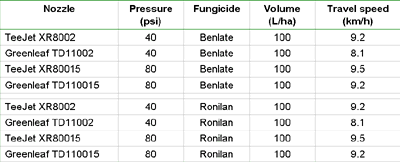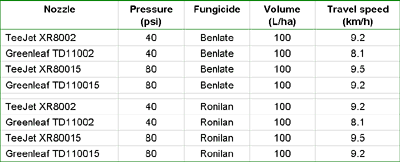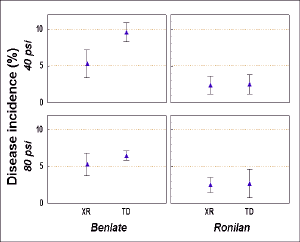Canola Agronomic Research Program
CARP AG#98-23
Spray Application Methods to Maximize
Sclerotinia Control in Canola
with Foliar Fungicide
Agriculture and Agri-Food Canada
1998 Final Report
Abstract:
Sprays of Ronilan and Benlate were applied to canola with 4 application methods to determine the impact of nozzle type and pressure on sclerotinia disease suppression. Both fungicides were highly effective, reducing disease incidence from 50% in the untreated plots to between 2 and 10% in treated plots, with a corresponding 30% yield increase. Overall, conventional flat fan nozzles (TeeJet XR) and low-drift Venturi nozzles (Greenleaf TurboDrop) were equally effective at reducing disease. Both 40 and 80 psi provided similar performance. There was a slight interaction among products and application method: Ronilan performance was not affected by nozzles and pressures, whereas Benlate performance was slightly reduced with the Venturi nozzles when they were operated at low pressure. Increasing the Venturi nozzle pressure to 80 psi improved disease control to a level equivalent to the XR nozzle. This interaction was not apparent in canola yield or seed quality. Based on one year's data, these results suggest that Venturi nozzle technology is appropriate for use with foliar fungicides for sclerotinia control in canola provided pressures are adjusted to optimize nozzle performance.
Background and Objectives:
Sclerotinia stem rot of canola caused by Sclerotinia sclerotiorum (Lib.) de Bary has long been a potential threat to canola production in the Parkland (Vanterpool 1957). Disease management consists of crop rotation and application of foliar fungicides at flowering. However the sclerotia produced by the pathogen survive for many years in soil, which limits the effectiveness of crop rotations of even 4 years (Morrall and Dueck 1982). Effectiveness of rotation is also limited because of the pathogen's ability to disperse air-borne inoculum. The introduction of other sclerotinia susceptible broadleaf crops in the rotation such as pulses and forage legumes further increases the risk of epidemic development. Resistant cultivars are not yet available, which leaves fungicide application as the most important control method for most producers.
Spray nozzle design has undergone significant advances over the past two years. Most notably, Venturi nozzle technology is rapidly being adopted as a means of improving deposition of sprays under windy conditions. Custom applicators are leading users of the technology, and many are considering wholesale switches to these new nozzles for all their applications, including fungicides. Although spray drift has historically not been considered a major concern for fungicides, the advantages of improving on-target deposition under a wider window of application can improve the timeliness and effectiveness of the spray application.
In order to achieve effective disease control and maximum economic benefit from fungicide application, growers need to know the impact that application equipment has on various control products. With this goal in mind a study was undertaken at Melfort Research Farm in 1998. The objectives were to determine the effect of low-drift nozzle technology on foliar fungicide application, to compare effectiveness of the products benomyl (Benlate) and vinclozolin (Ronilan) on disease suppression and to determine if there are interactions among application methods and products.
Experimental Method:
Canola (Quest) was direct-seeded at 5.6 kg/ha into wheat stubble on a Melfort silty-clay loam on May 10, 1998. Recommended fertilizer rates based on soil tests were applied at seeding, and weed control was obtained with an application of glyphosate (Roundup). On July 2, when the canola crop was at 30% bloom stage of flowering, it was sprayed with Benlate (1.0 kg/ha) and Ronilan (0.75 kg/ha) using a Melroe Spra-Coupe 220. Spray treatments were applied at 100 L/ha using conventional and venturi-type flat fan nozzles (Table 1). Plot size was 10 m wide by 25 m deep, arranged in a split plot design on a 2.2 ha site. Incidence of sclerotinia in 250 plant samples per treatment was assessed on August 14th. Plots were swathed August 17th and combined with a Massey 550 combine September 2nd.
Table 1. Treatment list for fungicide application experiments

TeeJet XR8002 and XR80015 are "Extended Range" flat fan nozzles commonly used for spray application of the majority of pesticides in Canada. At 40 psi, XR8002 tips produce a "medium" spray quality, whereas at 80 psi, XR80015 tips produce a "fine" spray quality. Greenleaf TurboDrop TD11002 and TD110015 are Venturi nozzles which emit a "very coarse" spray, even at higher pressures. This spray is noted for its extreme drift resistance, but little is known about impacts on fungicide efficacy.
Results and Discussion:
Sclerotinia was prevalent at Melfort in 1998, with a mean disease incidence of 51.6% in the untreated plots (Table 2). Both Ronilan and Benlate effectively managed disease, reducing sclerotinia incidence to a level of 2% to 10%, compared to the control (Table 2, Figure 1). Products were equally effective in controlling disease and protecting yield and quality. No differences were observed for any of the factors measured (Table 2). Nozzles did not differ in their ability to control disease or protect yield. Averaged over all treatments, plots treated with the XR tips had a disease incidence of 4±1, whereas the TD plots had a disease incidence of 5±1. On the whole, spray pressure had little impact, with 40 and 80 psi yielding disease incidences of 5±1 and 4±1, respectively. When factors were separated, nozzle or pressure choice made little difference to Ronilan effectiveness, producing good disease protection in all cases (Figure 1). For Benlate, however, TD nozzles performed less well than XR tips at 40 psi, but compared favourably with the XR at the higher pressure.
Table 2. Effect of application method and fungicide product on sclerotinia stem rot incidence, crop yield, thousand kernel weight (TKW), bushel weight (BW) and green seed at Melfort in 1998.


Figure 1: Sclerotinia disease incidence (% infected stems) on canola treated with two fungicides (Benlate and Ronilan) and two nozzle types (TeeJet XR and Greenleaf TurboDrop) at two pressures (40 and 80 psi).
Impact:
Under the conditions present at Melfort in 1998 both Benlate and Ronilan effectively suppressed sclerotinia in canola. Either product increased yield by approximately 30% over the untreated control. No improvement among treated and untreated plots was noted for thousand kernel weight, bushel weight or % green seed. Venturi type nozzles appear suited for use with foliar fungicides in canola, although spray pressure may need to be elevated to maintain comparable control. Interactions of nozzles with active ingredient warrants further investigations.
Literature Cited:
1. Morrall, R.A.A. and J. Dueck. 1982. Epidemiology of sclerotinia stem rot of rapeseed in Saskatchewan. Can. J. Plant Pathol. 4:161-168.
2. Vanterpool, T.C. 1957. Rape diseases in Saskatchewan in 1957. Can. Plant Dis. Surv. 37:38-39.
Dr. Thomas M. Wolf
Saskatoon Research Centre
107 Science Place, Saskatoon, SK S7N 0X2
Dr. H. Randy Kutcher
Melfort Research Farm
P.O. Box 1240, Highway 6 South
Melfort, SK S0E 1A0
Prepared for:
Canola Council of Canada
400-167 Lombard Avenue
Winnipeg, MB R3B 0T6
January, 1999
